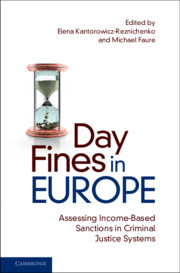
What if fines could be adjusted not only to the severity of the offense, but also to the income of the offender? What if the rich pay a higher fine than the poor for the same offense? This is not just a thought experiment but a real model, which was first introduced in Finland 100 years ago. Since then, already half of the European Union countries adopted this model that came to be known as “day fines”. But this movement is not dormant. On June 3, 2021, income-dependent fines came to the forefront of the public debate in the Netherlands. Identifying the problem that the financial capacity is insufficiently (if at all) taken into account when imposing a fine, the Dutch House of Representatives is looking into different models of pecuniary sanctions. One such model is the day fine.
Day fines, contrary to traditional fines, are not fixed. They are imposed using a two-stage procedure. First, the number of days to pay the fine is determined based on the severity of the offense. For example, a person may receive 10 days of fine for committing a minor theft offense, or a traffic offense. In the next step, the daily amount of the fine is determined based on the person’s income. For example, a person with a daily income of 100 euro would pay 50 euro while a person with a daily income of 20 euro will pay 10 euro per day. The result is that the richer offender will pay a total of 500 euro fine (10 x 50) and the lower-income offender will pay 200 euro fine (10 x 20) for the same offense. One of the most sensational examples often cited is the above 100.000 euro fine imposed on a CEO of Nokia in Finland for speeding. Even though at first such a fine seems completely disproportionate, the number of days which were imposed was only 12, which fits the severity of the offense. The high total fine resulted from the exceptionally high income of the defendant.
The appeal in this system is the ability to impose a similar punitive bite on offenders with different levels of wealth. With traditional fines the rich can simply “buy the right” to commit an offense, while poor offenders might end up in prison just for the reason of not being able to afford the same fine. Day fines introduce fairness into the criminal justice system and move away from the regressive type of a fine. Because in practice the same amount of fine constitutes a larger portion of a poor person’s income than a rich person’s income.
With the right implementation, day fines have other expected advantages, such as becoming a reliable alternative sanction to short-term imprisonment; increasing uniformity in sentencing; enhancing transparency in sentencing. All these advantages led a large portion of the EU countries to switch to this model of fine. This movement started by some of the Scandinavian countries in the first part of the 20th century, followed by Germany and Austria in 1975 and later transplanted to other countries. And given the current discussion in the Netherlands, the diffusion of this system is ongoing.
The day fine model is of course not free of challenges. In order for it to really reach its goals a broad access to financial information needs to be provided. Additionally, guidelines for calculating the fine need to be detailed and clear. Otherwise, this sanction risks overcomplicating the sanctioning process. Such complication might hamper entirely the efficient implementation of the fine system since often it concerns very low fines which might “not worth the effort”. Moreover, if not properly explained to the public, and not well received by the judges who are expected to impose these fines, day fines might face resistance. England and Wales is a good example where the system was introduced and abolished merely seven months later due to resistance from different actors. Therefore, the excitement about this exotic form of fines should be complemented with careful consideration before adopting this model in any new legal system.

Featured image: Photo by Josh Appel on Unsplash

Latest Comments
Have your say!